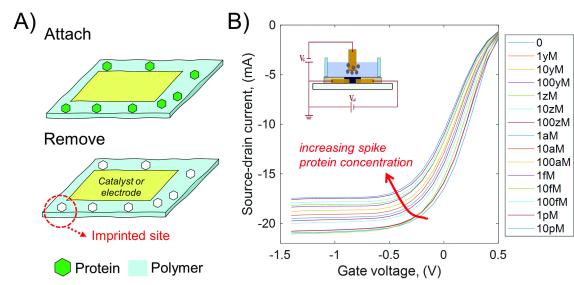The COVID-19 pandemic has revealed serious deficiencies in our ability to contain disease-causing pathogens that are transmitted via aerosols. Prior to the pandemic, aerosol transmission was believed to be relatively uncommon and unimportant compared to transmission through large droplets and by surface contamination. However, recent investigations have demonstrated that SARS-CoV-2, the virus that causes COVID-19, is primarily transmitted via aerosols.
Developing effective technologies for detecting aerosolized viruses is critical to limiting their spread. Of greatest value is the capability for rapid in situ detection with high sensitivity, specificity, and reliability. The concentration of aerosolized virus is typically very low, at approximately 1–1,000 particles per m3 of air for an infected individual breathing normally. The sensors should be tuned to respond only to a specific viral threat and not others to avoid false positives. This type of sensor will be most impactful if it can be manufactured and distributed cheaply, and ideally the sensor would be disposable.
With support from the National Science Foundation (NSF), a team of researchers at Rice Univ. led by Pedro Alvarez, Rafael Verduzco, and Jane Tao addressed these challenges through the development of a polymer material that can bind specifically to SARS-CoV-2 and a sensor platform for rapidly detecting SARS-CoV-2.

▲ (a) Researchers synthesized molecularly imprinted polymers that recognize the target virus and can be coated on organic electrochemical transistors (OECTs). (b) OECT response to the SARS-CoV-2 spike protein is shown. (c) The device can quantify the presence of spike protein in solution and detect concentrations as low as 10–20 M.
At the heart of the technology is the concept of molecular recognition via molecular imprinting techniques; essentially, a lock-and-key arrangement where the binding site on the sensor has a precise molecular shape for the virus to attach to. The researchers developed molecularly imprinted polymers (MIPs) using an organosilane coating on the surface of silica particles. Working with the human coronavirus HCoV-OC43 as a model system, they demonstrated that this coating could rapidly adsorb HCoV-OC43 from deposited aerosols, resulting in successful detection within a minute.
The team also developed rapid electronic sensors for SARS-CoV-2 by coupling the MIP materials with organic electrochemical transistors (OECTs). OECTs are devices that have several attractive features for biosensing: they are stable in aqueous and biological environments, they can be fabricated cheaply, and they amplify biomolecular binding to electrodes by producing a large electronic output upon binding.
The team demonstrated that specific binding to and sensitive detection of SARS-CoV-2 could be achieved in OECTs using various biomolecules that bind strongly to the virus. This included the commercially available polysaccharide heparin, the engineered protein LCB1, and a modified nanobody VHH72. In each of these cases, modification of the channel or gate electrodes produced a significant response to SARS-CoV-2. The OECT devices have three electrodes — a source, a drain, and a gate — and binding of the SARS-CoV-2 spike protein to the gate produces a measurable change in the source-drain current. By varying the concentration of the spike protein (tested separately from the intact virus) from 10–24 M up to 10–11 M, they achieved a limit of detection (LoD) of 10–20 M for SARS-CoV-2 spike protein.
Importantly, the researchers also demonstrated that the system could detect whole SARS-CoV-2 virus (with a LoD of 40 plaque-forming units [pfu]/mL) using inactivated virus samples. In addition, the system was non-responsive to MERS-CoV and influenza viruses.
Overall, this work demonstrates a versatile approach to the rapid, sensitive, and specific detection of viruses. Importantly, the approach to molecular recognition using MIPs and modified antibodies is sufficiently general and can be tailored to detect other viruses of interest, such as influenza A, smallpox, or future viral threats that emerge.
This research related to COVID-19 is supported by an NSF Rapid Response Research grant.
This article was prepared by the National Science Foundation in partnership with CEP.

Copyright Permissions
Would you like to reuse content from CEP Magazine? It’s easy to request permission to reuse content. Simply click here to connect instantly to licensing services, where you can choose from a list of options regarding how you would like to reuse the desired content and complete the transaction.
